Effects of Damaged Rotor Blades on the Aerodynamic Behavior and Heat-Transfer Characteristics of High-Pressure Gas Turbines
Abstract
:1. Introduction
2. Simulation Details
2.1. Geometry and Grid
2.2. Governing Equations and Turbulence Model
2.3. Boundary Conditions and Unsteady Simulation
3. Results and Discussion
3.1. Flow Characteristics
3.2. Aerodynamic Behavior
3.3. Heat-Transfer Characteristics
4. Conclusions
Author Contributions
Funding
Institutional Review Board Statement
Informed Consent Statement
Data Availability Statement
Conflicts of Interest
Nomenclature
| Fluid density (kg/) | |
| u | Fluid velocity (m/s) |
| P | Fluid pressure (Pa) |
| Fluid viscosity (Pa·s) | |
| E | Specific internal energy (J) |
| Effective thermal conductivity (W/m·K) | |
| Effective dynamic viscosity (Pa·s) | |
| Turbulence viscosity (Pa·s) | |
| Blending functions | |
| Turbulence kinetic energy (J/kg) | |
| Eddy dissipation/Angular velocity (rad/s) | |
| Turbulent Prandtl number for | |
| Turbulent Prandtl number for | |
| Intermittency | |
| S | Strain rate magnitude () |
| Empirical correlation | |
| Vorticity magnitude | |
| Critical Reynolds number | |
| Heat flux (W/) | |
| Temperature of the wall surface [K] | |
| Temperature in isothermal condition [K] | |
| Specific heat of ideal air [J/kg·K] | |
| κ | Ratio of specific heat |
| Turbulent Prandtl number for | |
| Intermittency | |
| S | Strain rate magnitude () |
References
- Ramireddy, V. An Overview of Combined Cycle Power Plant. 2012. Available online: https://electrical-engineering-portal.com/an-overview-of-combined-cycle-power-plant (accessed on 18 January 2021).
- An, B.-T.; Liu, J.-J.; Jiang, H.-D. Numerical Investigation on Unsteady Effects of Hot Streak on Flow and Heat Transfer in a Turbine Stage. J. Turbomach. 2009, 131, 031015. [Google Scholar] [CrossRef]
- Povey, T.; Qureshi, I. Developments in hot-streak simulators for turbine testing. J. Turbomach. 2009, 131, 031009. [Google Scholar] [CrossRef]
- Kaewbumrung, M.; Tangsopa, W.; Thongsri, J. Investigation of the trailing edge modification effect on compressor blade aerodynamics using SST k-ω turbulence model. Aerospace 2019, 6, 48. [Google Scholar] [CrossRef] [Green Version]
- Mai, T.D.; Ryu, J. Effects of Leading-Edge Modification in Damaged Rotor Blades on Aerodynamic Characteristics of High-Pressure Gas Turbine. Mathematics 2020, 8, 2191. [Google Scholar] [CrossRef]
- Gallardo, J.; Rodríguez, J.; Herrera, E. Failure of gas turbine blades. Wear 2002, 252, 264–268. [Google Scholar] [CrossRef]
- Mishra, R.; Thomas, J.; Srinivasan, K.; Nandi, V.; Bhatt, R.R. Failure analysis of an un-cooled turbine blade in an aero gas turbine engine. Eng. Fail. Anal. 2017, 79, 836–844. [Google Scholar] [CrossRef]
- Poursaeidi, E.; Aieneravaie, M.; Mohammadi, M. Failure analysis of a second stage blade in a gas turbine engine. Eng. Fail. Anal. 2008, 15, 1111–1129. [Google Scholar] [CrossRef]
- Yu, Z.-Y.; Zhu, S.-P.; Liu, Q.; Liu, Y. A New Energy-Critical Plane Damage Parameter for Multiaxial Fatigue Life Prediction of Turbine Blades. Materials 2017, 10, 513. [Google Scholar] [CrossRef] [Green Version]
- Liu, Z.; Karimi, I.A. Gas turbine performance prediction via machine learning. Energy 2020, 192, 116627. [Google Scholar] [CrossRef]
- Zhou, D.; Yao, Q.; Wu, H.; Ma, S.; Zhang, H. Fault diagnosis of gas turbine based on partly interpretable convolutional neural networks. Energy 2020, 200, 117467. [Google Scholar] [CrossRef]
- Bazilevs, Y.; Takizawa, K.; Wu, M.C.; Kuraishi, T.; Avsar, R.; Xu, Z.; Tezduyar, T.E. Gas turbine computational flow and structure analysis with isogeometric discretization and a complex-geometry mesh generation method. Comput. Mech. 2021, 67, 57–84. [Google Scholar] [CrossRef]
- Simone, S.; Montomoli, F.; Martelli, F.; Chana, K.S.; Qureshi, I.; Povey, T. Analysis on the Effect of a Nonuniform Inlet Profile on Heat Transfer and Fluid Flow in Turbine Stages. J. Turbomach. 2011, 134, 011012. [Google Scholar] [CrossRef]
- Choi, M.G.; Ryu, J. Numerical study of the axial gap and hot streak effects on thermal and flow characteristics in two-stage high pressure gas turbine. Energies 2018, 11, 2654. [Google Scholar] [CrossRef] [Green Version]
- Wang, Z.; Liu, Z.; Feng, Z. Influence of mainstream turbulence intensity on heat transfer characteristics of a high pressure turbine stage with inlet hot streak. J. Turbomach. 2016, 138, 041005. [Google Scholar] [CrossRef]
- Yang, D.; Yu, X.; Feng, Z. Investigation of Leakage Flow and Heat Transfer in a Gas Turbine Blade Tip with Emphasis on the Effect of Rotation. J. Turbomach. 2010, 132, 041010. [Google Scholar] [CrossRef]
- Asgarshamsi, A.; Benisi, A.H.; Assempour, A.; Pourfarzaneh, H. Multi-objective optimization of lean and sweep angles for stator and rotor blades of an axial turbine. Proc. Inst. Mech. Eng. Part G J. Aerosp. Eng. 2015, 229, 906–916. [Google Scholar] [CrossRef]
- Pogorelov, A.; Meinke, M.; Schröder, W. Large-eddy simulation of the unsteady full 3D rim seal flow in a one-stage axial-flow turbine. Flow Turbul. Combust. 2019, 102, 189–220. [Google Scholar] [CrossRef]
- Zhang, B.; Qiang, X. Aerothermal and aerodynamic performance of turbine blade squealer tip under the influence of guide vane passing wake. Proc. Inst. Mech. Eng. Part A J. Power Energy 2020. [Google Scholar] [CrossRef]
- Timko, L. Energy Efficient Engine High Pressure Turbine Component Test Performance Report; Technical Report; National Aeronautics and Space Administration (NASA): Cincinnati, OH, USA, 1984. [Google Scholar]
- Arnone, A.; Benvenuti, E. Three-Dimensional Navier-Stokes Analysis of a Two-Stage Gas Turbine; American Society of Mechanical Engineers: New York, NY, USA, 1994. [Google Scholar]
- ANSYS. ANSYS TurboGrid Tutorials, Release 15.0; ANSYS: Canonsburg, PA, USA, 2013. [Google Scholar]
- ANSYS. ANSYS CFX, 12.1 Ansys Cfx-Solver Theory Guide; ANSYS: Canonsburg, PA, USA, 2009. [Google Scholar]
- Celik, I.; Yavuz, I.; Smirnov, A. Large eddy simulations of in-cylinder turbulence for internal combustion engines: A review. Int. J. Engine Res. 2001, 2, 119–148. [Google Scholar] [CrossRef]
- Ryu, J.; Lele, S.; Viswanathan, K. Study of supersonic wave components in high-speed turbulent jets using an LES database. J. Sound Vib. 2014, 333, 6900–6923. [Google Scholar] [CrossRef]
- Ryu, J.; Livescu, D. Turbulence structure behind the shock in canonical shock–vortical turbulence interaction. J. Fluid Mech. 2014, 756, R1-1–R1-13. [Google Scholar] [CrossRef] [Green Version]
- Lee, J.; Lee, H.J.; Ryu, J.; Lee, S.H. Three-dimensional turbulent flow and heat transfer characteristics of longitudinal vortices embedded in turbulent boundary layer in bent channels. Int. J. Heat Mass Transf. 2018, 117, 958–965. [Google Scholar] [CrossRef]
- Ngo, T.T.; Phu, N.M. Computational fluid dynamics analysis of the heat transfer and pressure drop of solar air heater with conic-curve profile ribs. J. Therm. Anal. Calorim. 2020, 139, 3235–3246. [Google Scholar] [CrossRef]
- Nguyen, M.P.; Ngo, T.T.; Le, T.D. Experimental and numerical investigation of transport phenomena and kinetics for convective shrimp drying. Case Stud. Therm. Eng. 2019, 14, 100465. [Google Scholar] [CrossRef]
- Phu, N.M.; Tuyen, V.; Ngo, T.T. Augmented heat transfer and friction investigations in solar air heater artificially roughened with metal shavings. J. Mech. Sci. Technol. 2019, 33, 3521–3529. [Google Scholar] [CrossRef]
- Kim, J.; Bak, J.; Kang, Y.; Cho, L.; Cho, J. A study on the numerical analysis methodology for thermal and flow characteristics of high pressure turbine in aircraft gas turbine engine. KSFM J. Fluid Mach. 2014, 17, 46–51. [Google Scholar] [CrossRef]
- Le, T.T.G.; Jang, K.S.; Lee, K.-S.; Ryu, J. Numerical Investigation of Aerodynamic Drag and Pressure Waves in Hyperloop Systems. Mathematics 2020, 8, 1973. [Google Scholar] [CrossRef]
- Oh, J.-S.; Kang, T.; Ham, S.; Lee, K.-S.; Jang, Y.-J.; Ryou, H.-S.; Ryu, J. Numerical analysis of aerodynamic characteristics of hyperloop system. Energies 2019, 12, 518. [Google Scholar] [CrossRef] [Green Version]
- Hylton, L.; Mihelc, M.; Turner, E.; Nealy, D.; York, R. Analytical and Experimental Evaluation of the Heat Transfer Distribution over the Surfaces of Turbine Vanes; Final Report Detroit Diesel Allison: Indianapolis, IN, USA, 1983. [Google Scholar]
- Menter, F.R. Two-equation eddy-viscosity turbulence models for engineering applications. AIAA J. 1994, 32, 1598–1605. [Google Scholar] [CrossRef] [Green Version]
- ANSYS. ANSYS Fluent Theory Guide; ANSYS: Canonsburg, PA, USA, 2013. [Google Scholar]
- Wang, Z.; Wang, D.; Liu, Z.; Feng, Z. Numerical analysis on effects of inlet pressure and temperature non-uniformities on aero-thermal performance of a HP turbine. Int. J. Heat Mass Transf. 2017, 104, 83–97. [Google Scholar] [CrossRef]
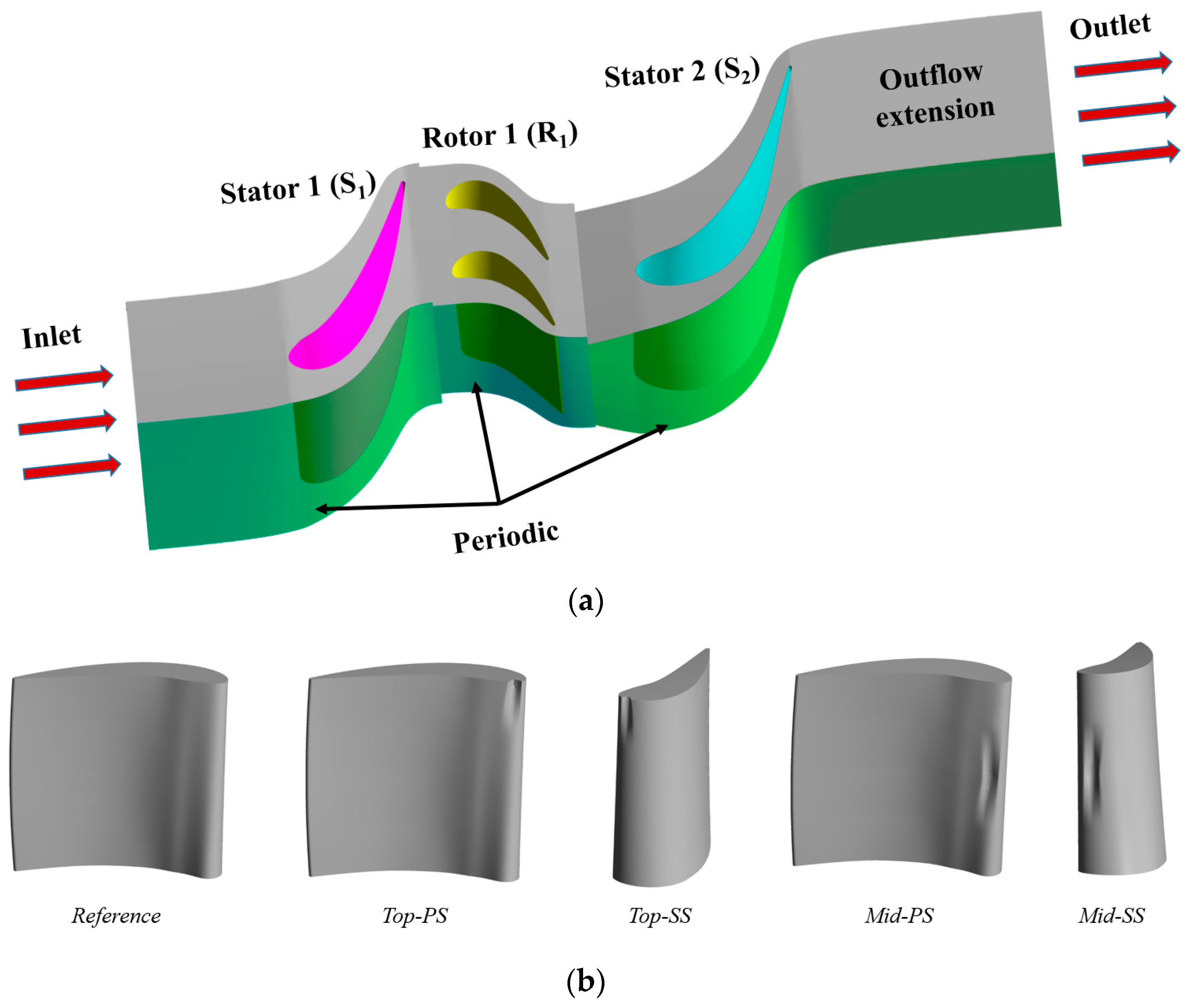


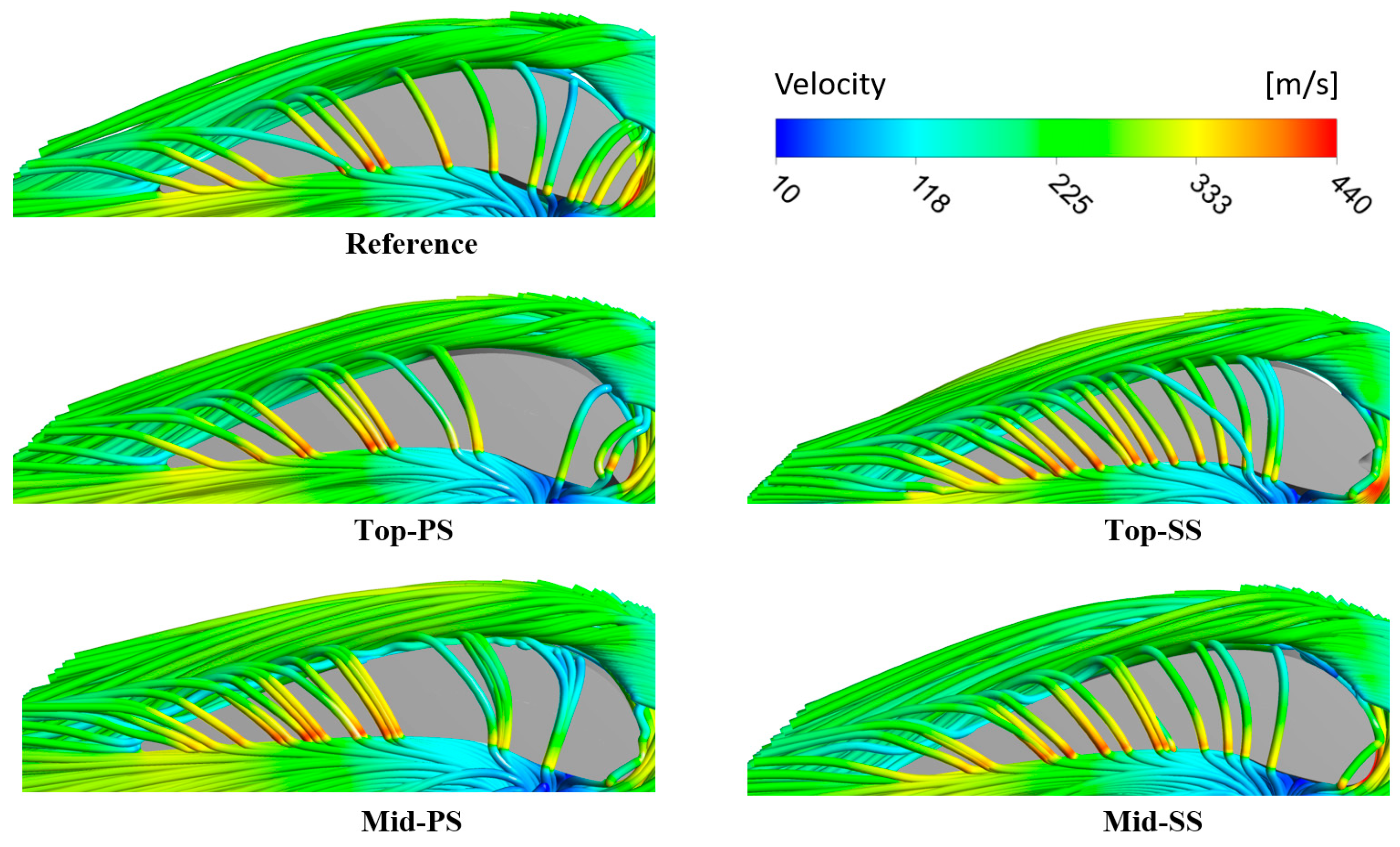

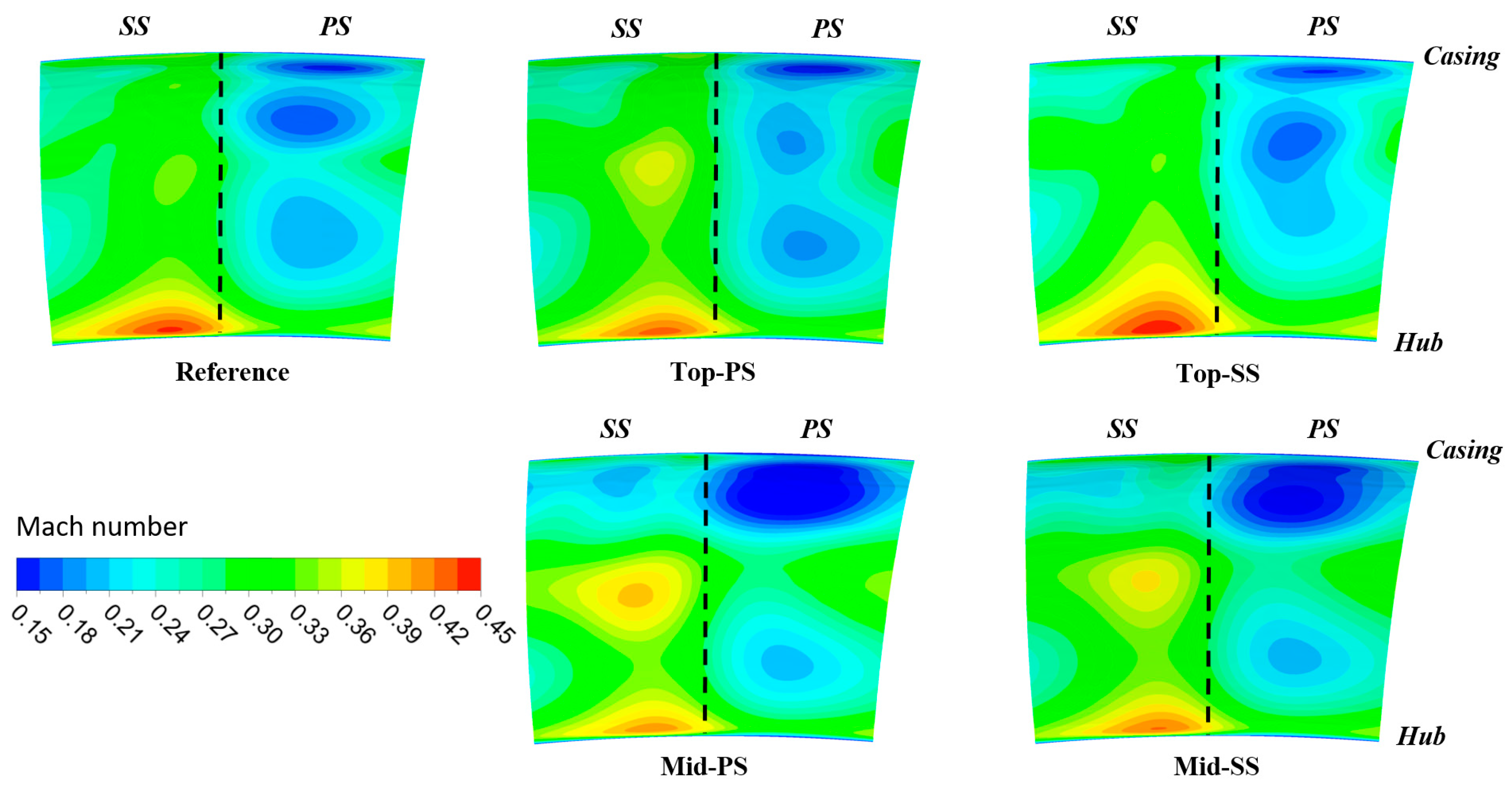

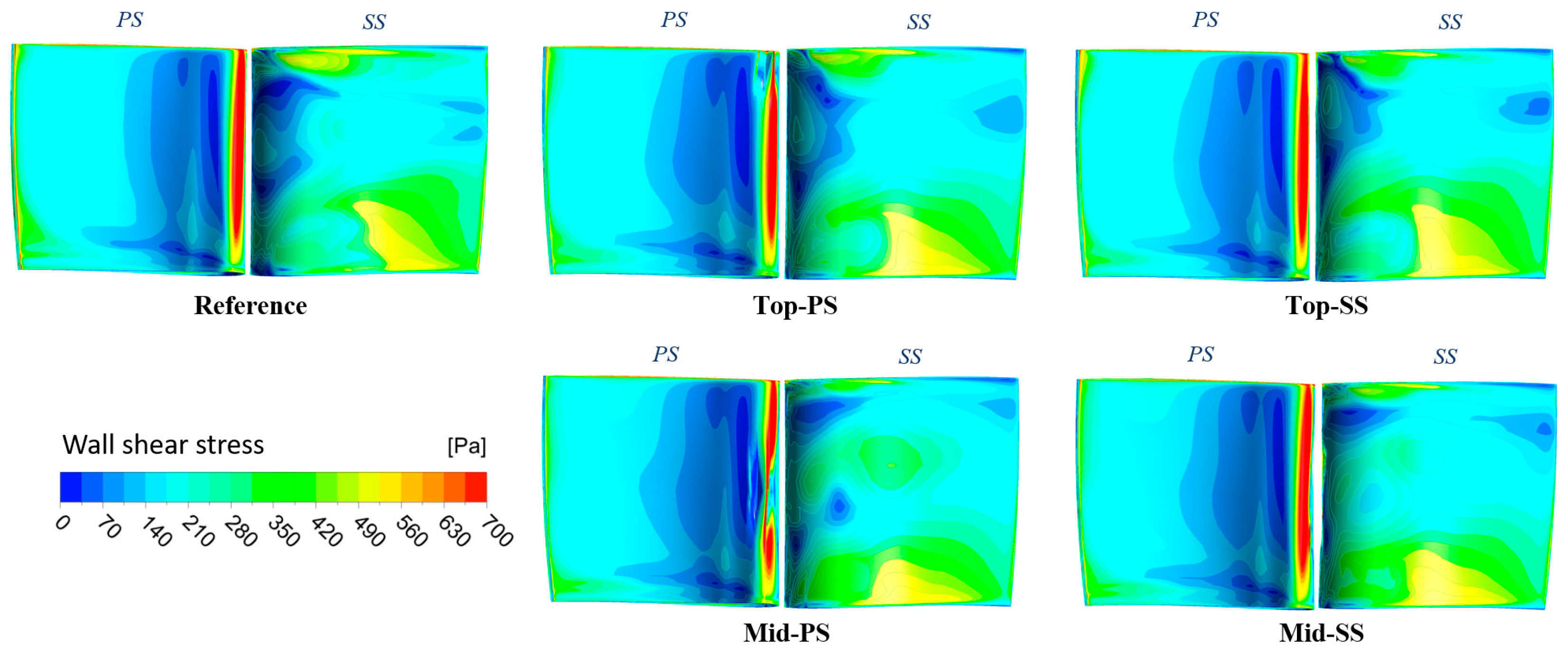
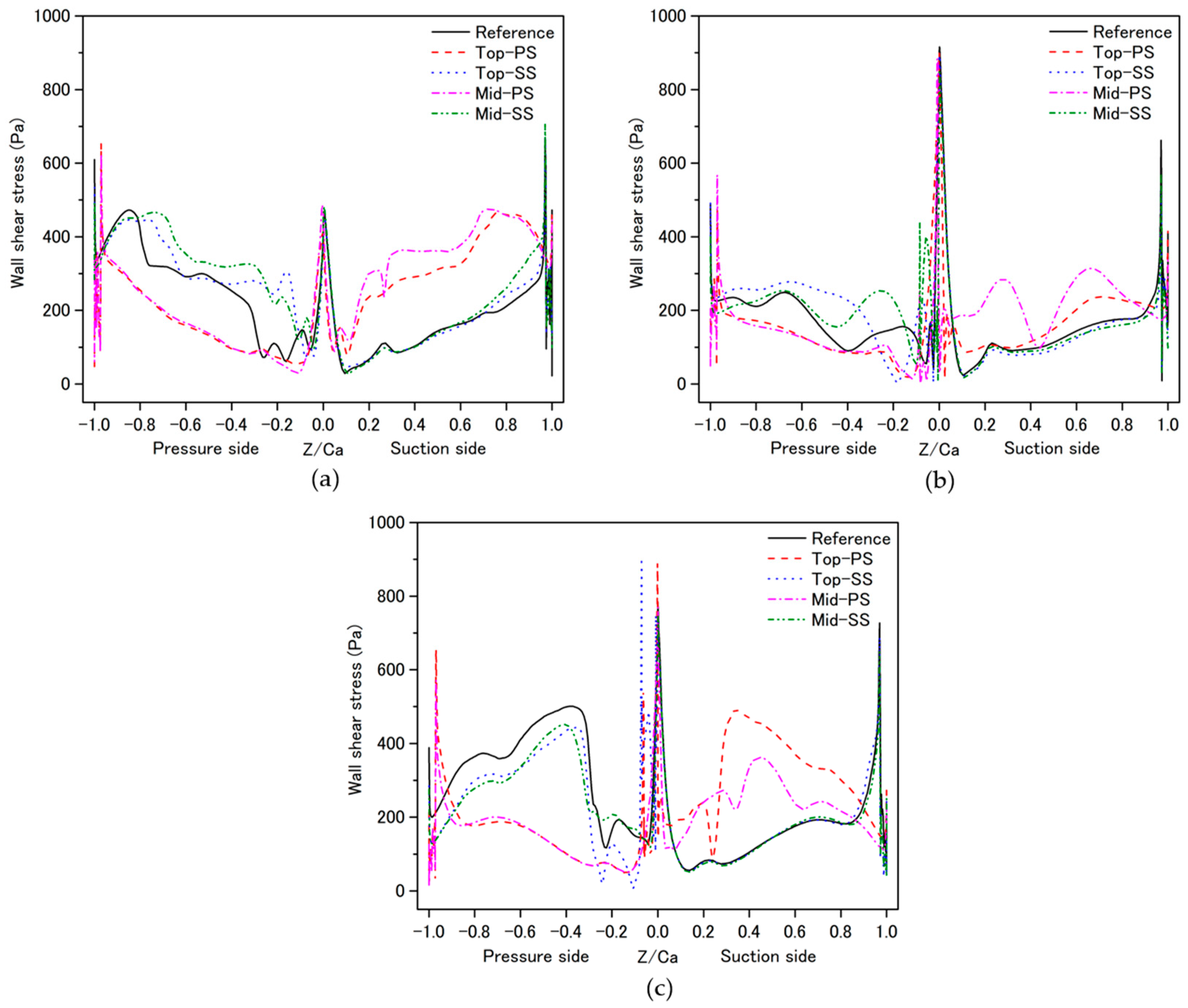
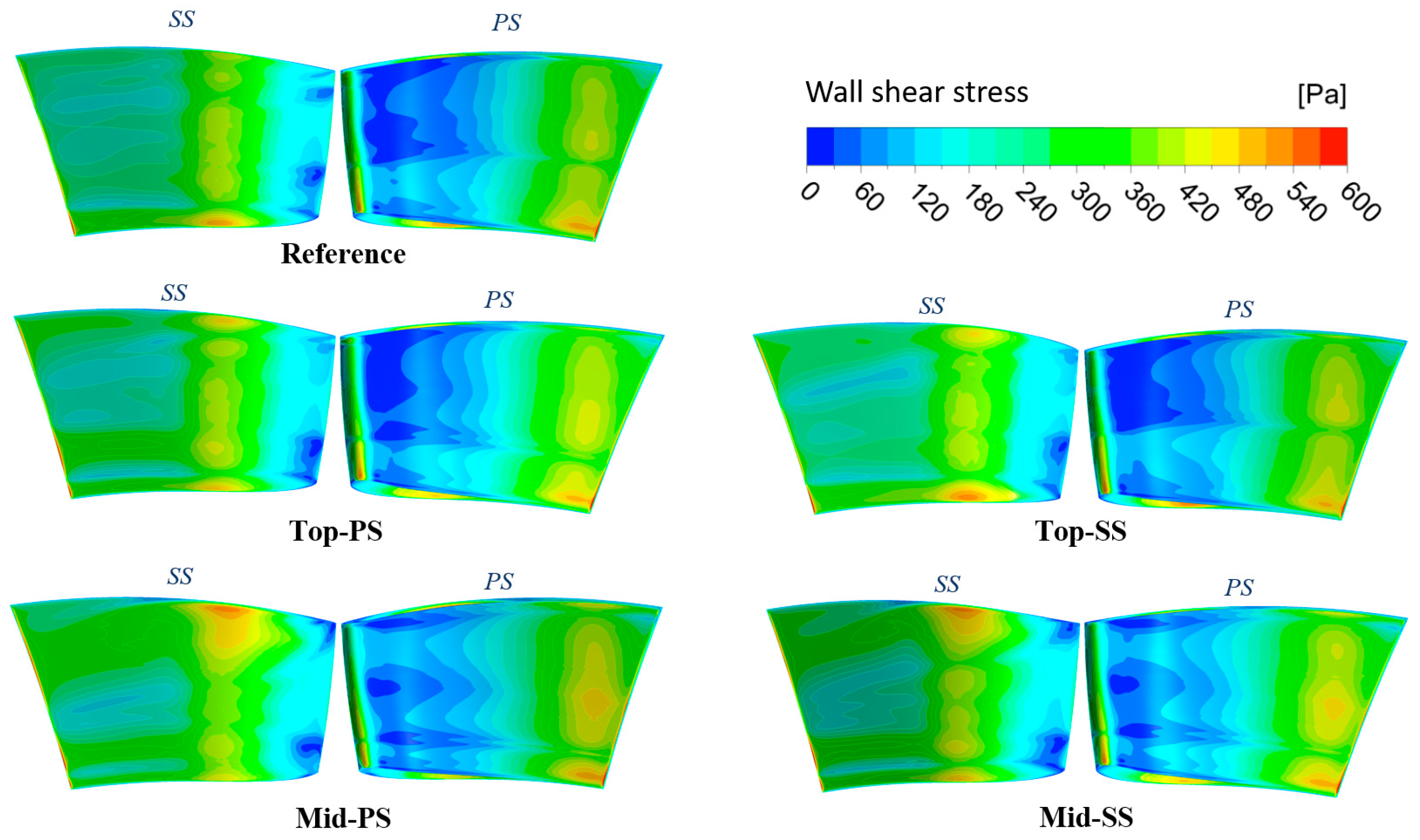
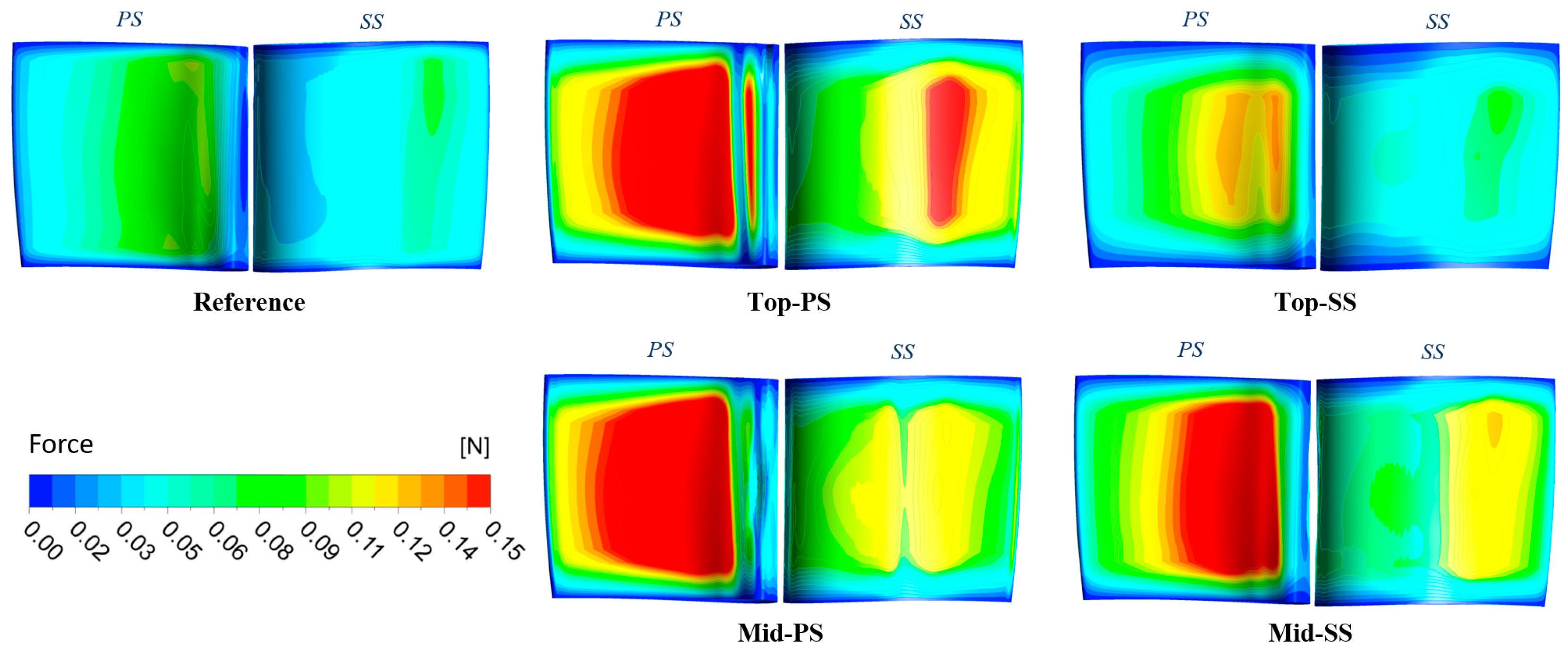

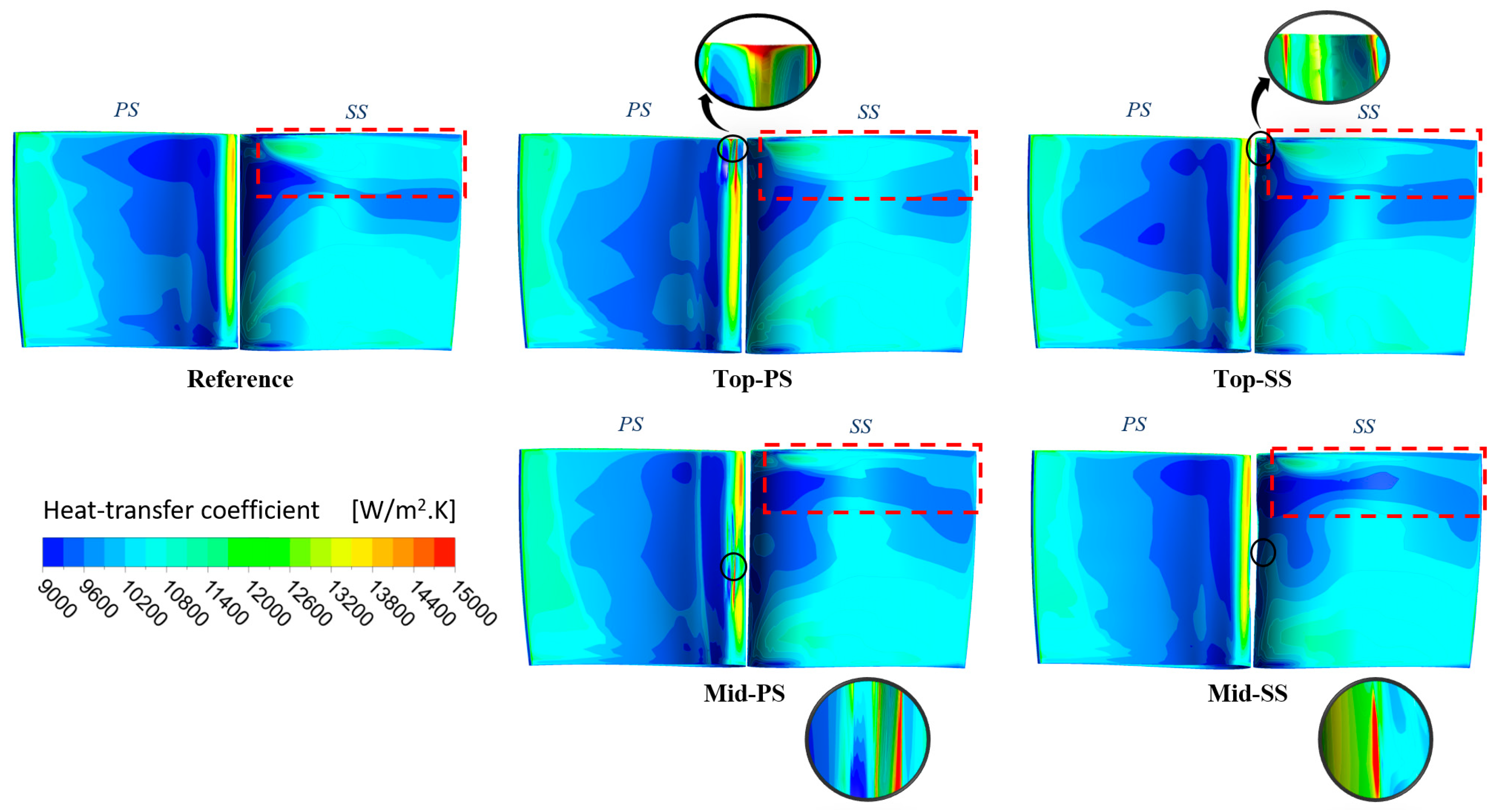
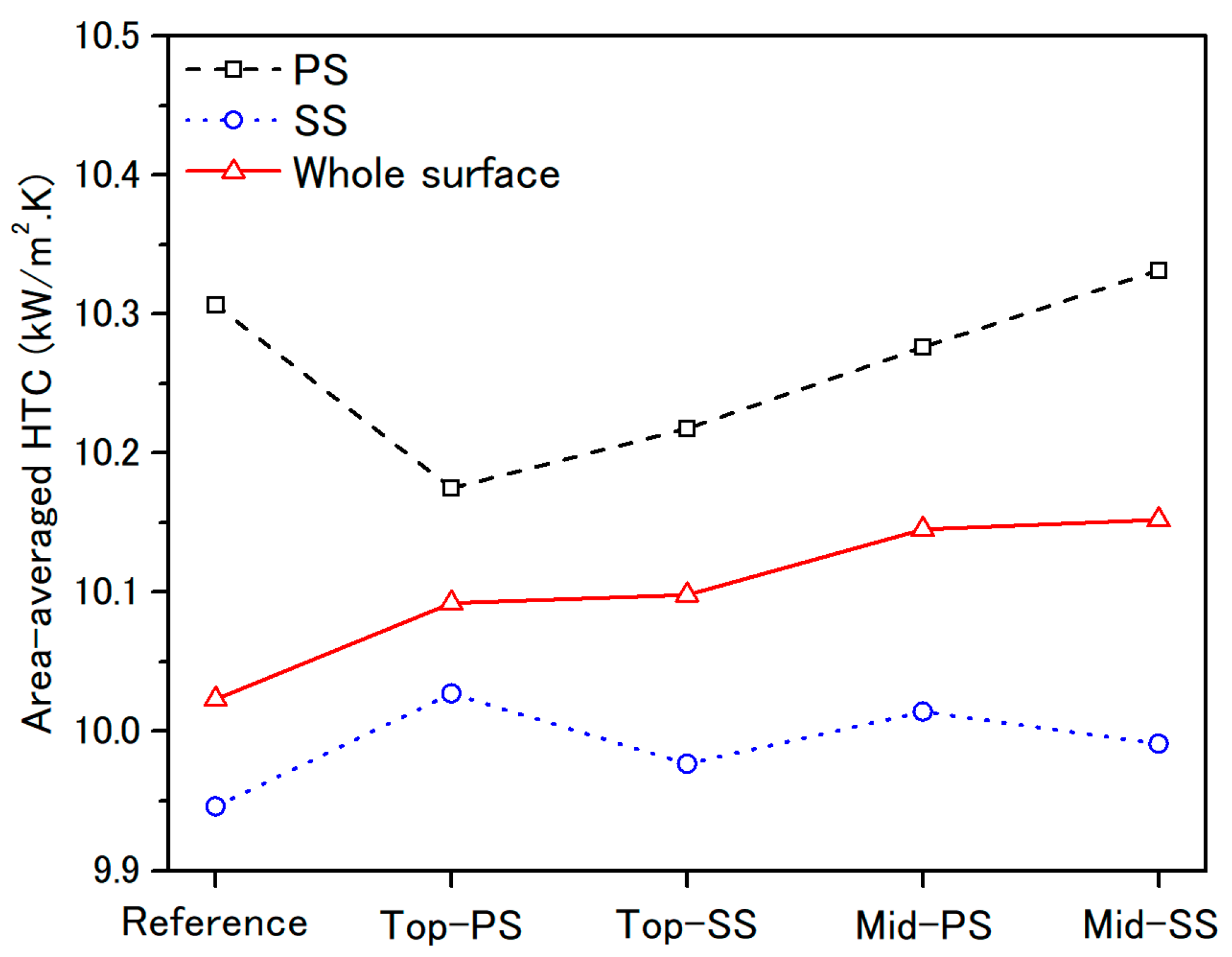
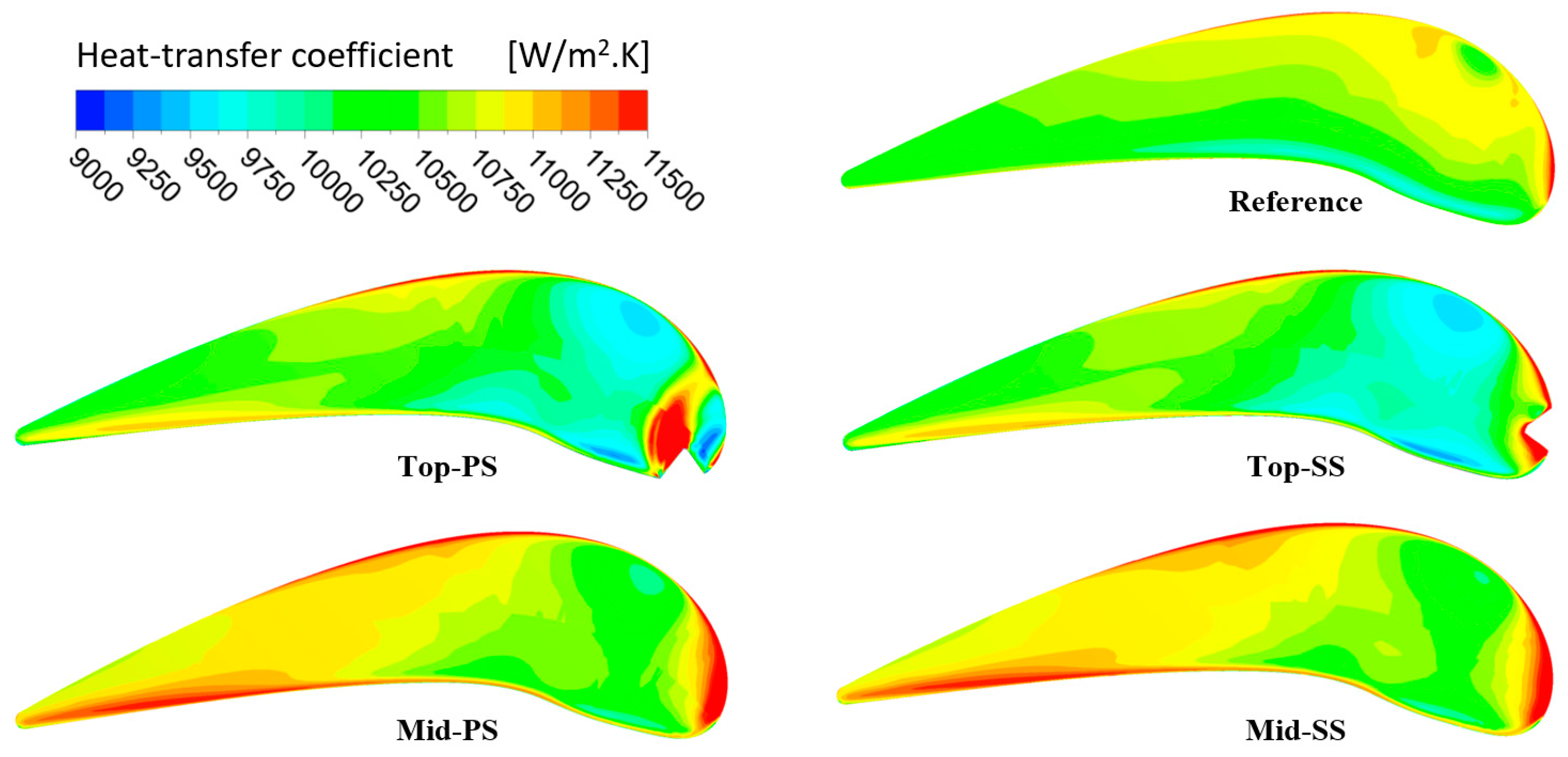
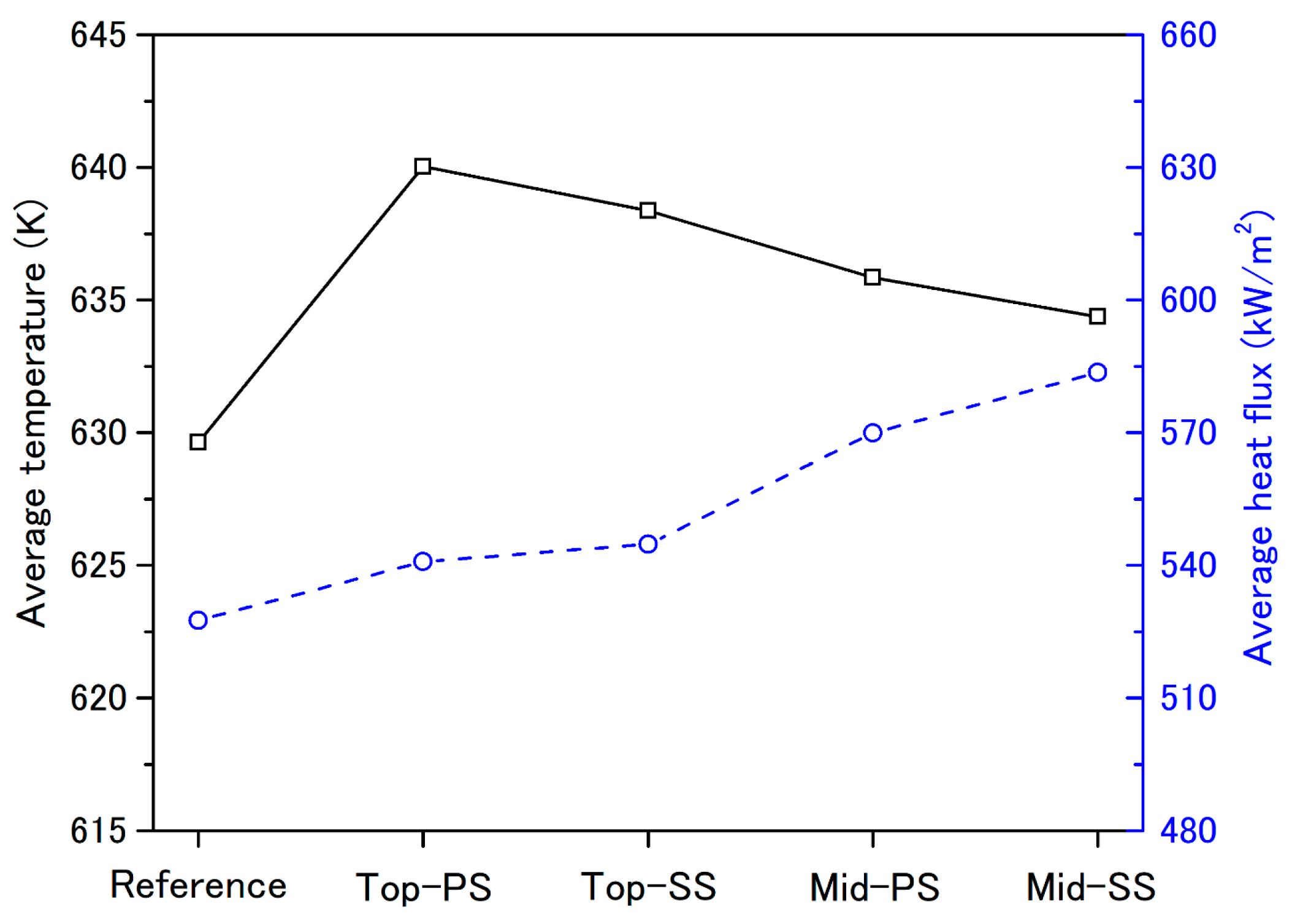
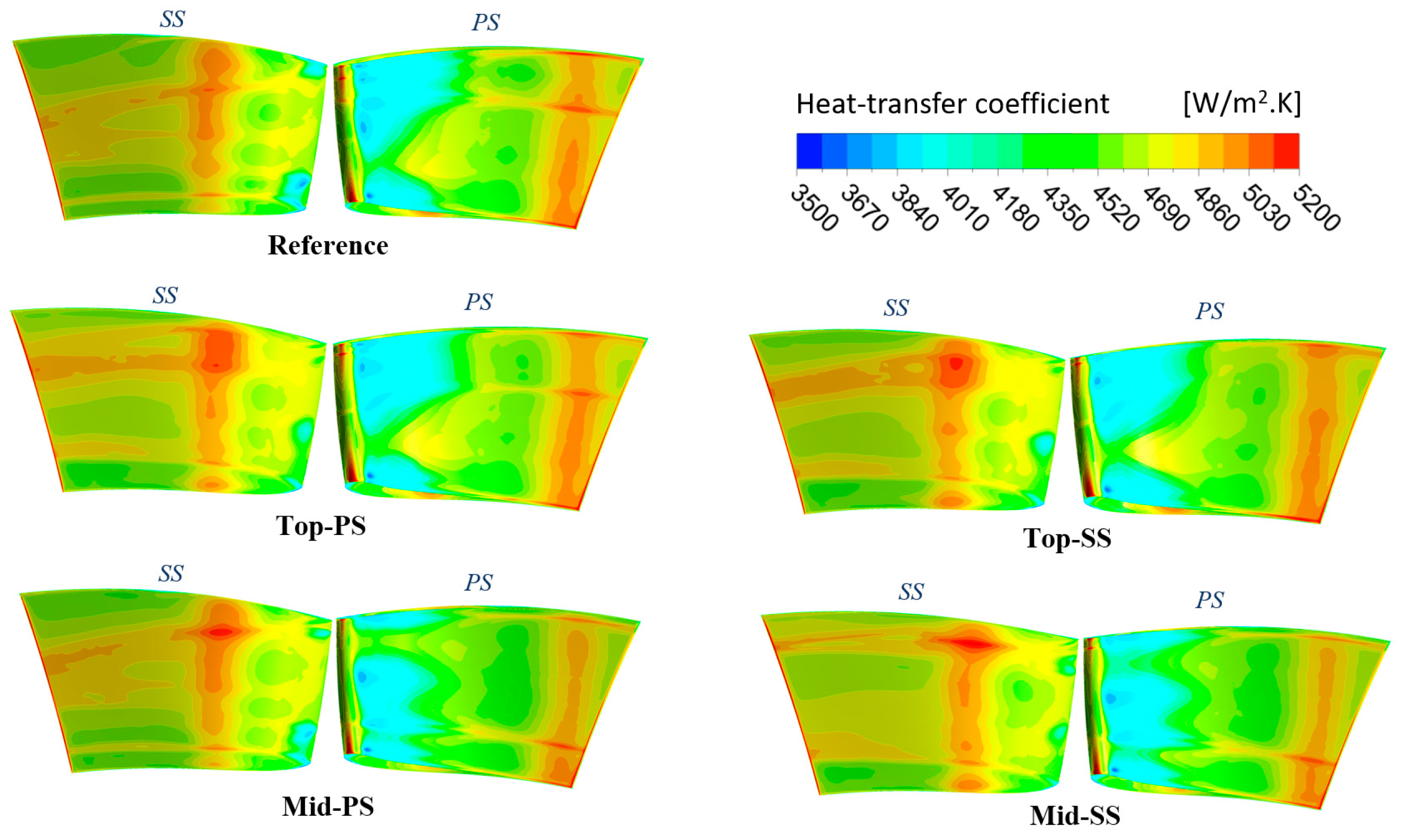
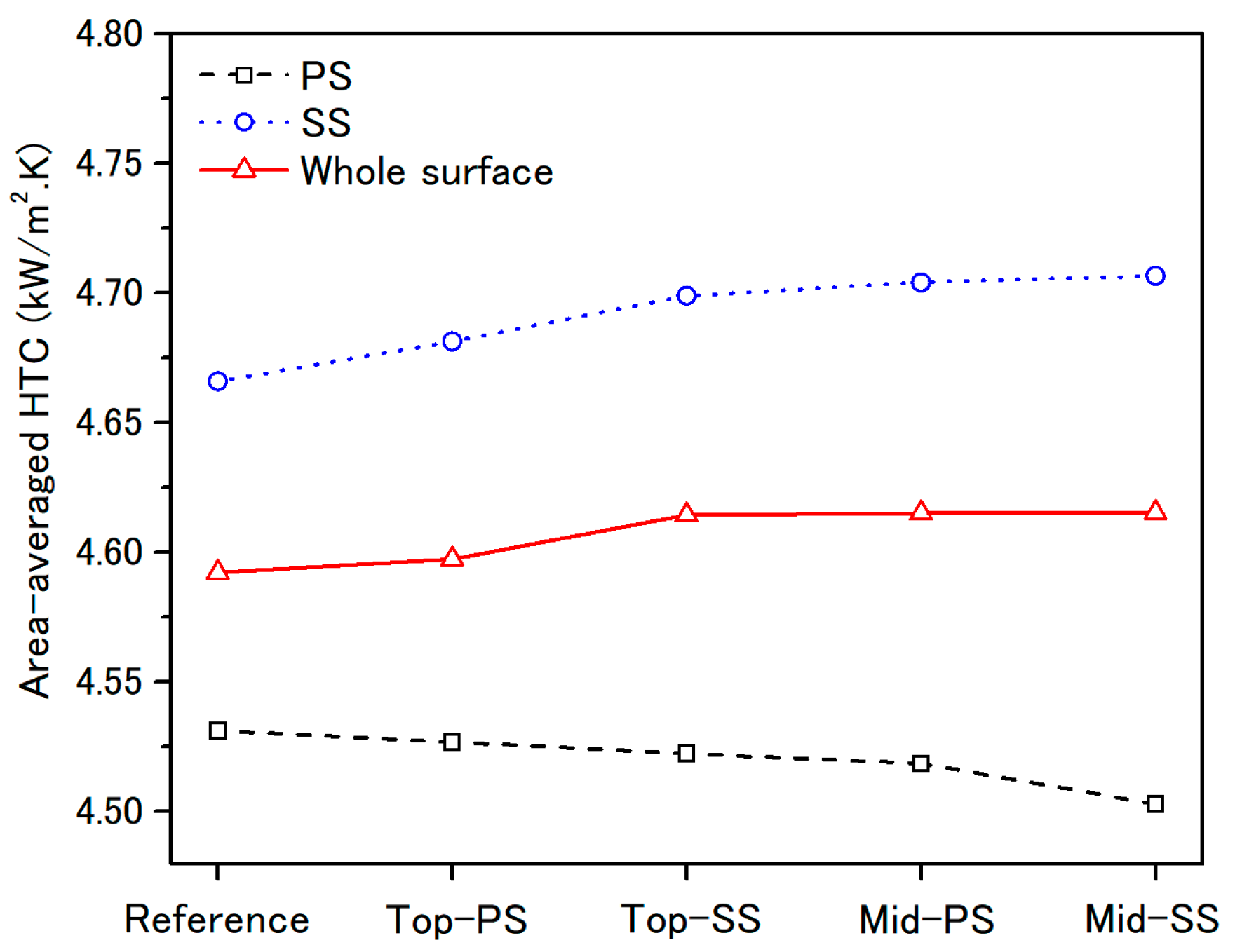
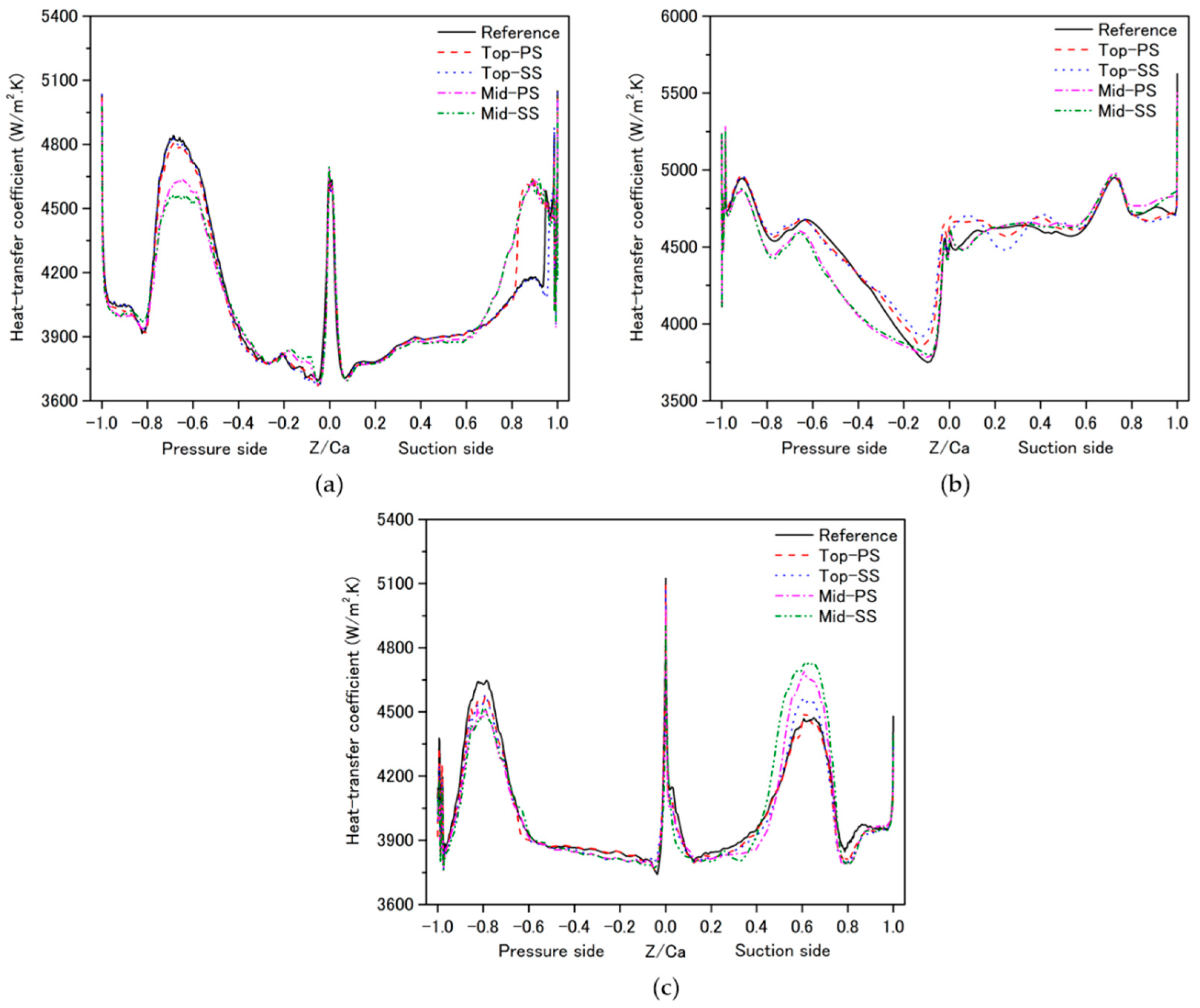
| Domain Node Number (×106) | Area-Averaged Heat Flux [kW/m2K] | ||||||
|---|---|---|---|---|---|---|---|
| S1 | R1 | S2 | S1 | Relative Error | R1 (Relative Error) | S2 (Relative Error) | |
| Mesh-1 | 0.99 | 2.48 | 1.34 | 277,226 | Relative errors are less than 0.01% | 382.85 (0.75%) | 276.97 (1.06%) |
| Mesh-2 | 1.32 | 4.42 | 1.8 | 277,022 | 385.73 (0.41%) | 279.91 (0.82%) | |
| Mesh-3 | 1.82 | 5.92 | 2.4 | 276,993 | 387.29 | 282.21 (0.43%) | |
| Mesh-4 | - | - | 3.2 | - | - | 283.41 | |
| Boundary Conditions | |
| Inlet | Total pressure: 344,740 Pa Total temperature: Hot streak (maximum: 839 K, average: 728 K) Turbulence intensity: 5% |
| Outlet | Static pressure: 104,470 Pa |
| Detailed Settings for Simulation | |
| Rotor speed | 3600 RPM |
| Rotor blades condition | Undamaged or damaged at PS and SS in middle and top of blade |
| Wall surface | Adiabatic or isothermal |
| Stator–rotor interface | Steady simulation: Frozen rotor Unsteady simulation: Transient rotor-stator |
Publisher’s Note: MDPI stays neutral with regard to jurisdictional claims in published maps and institutional affiliations. |
© 2021 by the authors. Licensee MDPI, Basel, Switzerland. This article is an open access article distributed under the terms and conditions of the Creative Commons Attribution (CC BY) license (http://creativecommons.org/licenses/by/4.0/).
Share and Cite
Mai, T.D.; Ryu, J. Effects of Damaged Rotor Blades on the Aerodynamic Behavior and Heat-Transfer Characteristics of High-Pressure Gas Turbines. Mathematics 2021, 9, 627. https://doi.org/10.3390/math9060627
Mai TD, Ryu J. Effects of Damaged Rotor Blades on the Aerodynamic Behavior and Heat-Transfer Characteristics of High-Pressure Gas Turbines. Mathematics. 2021; 9(6):627. https://doi.org/10.3390/math9060627
Chicago/Turabian StyleMai, Thanh Dam, and Jaiyoung Ryu. 2021. "Effects of Damaged Rotor Blades on the Aerodynamic Behavior and Heat-Transfer Characteristics of High-Pressure Gas Turbines" Mathematics 9, no. 6: 627. https://doi.org/10.3390/math9060627
APA StyleMai, T. D., & Ryu, J. (2021). Effects of Damaged Rotor Blades on the Aerodynamic Behavior and Heat-Transfer Characteristics of High-Pressure Gas Turbines. Mathematics, 9(6), 627. https://doi.org/10.3390/math9060627






